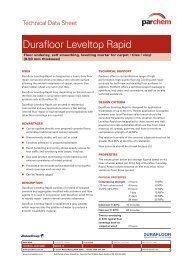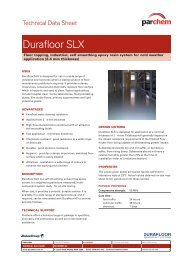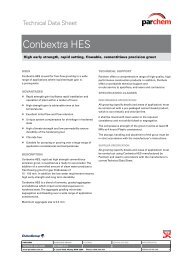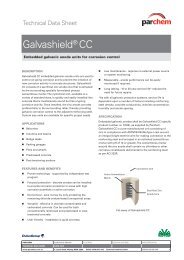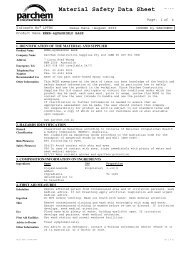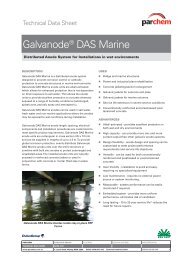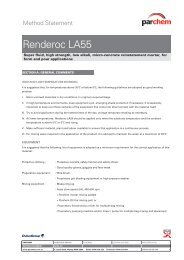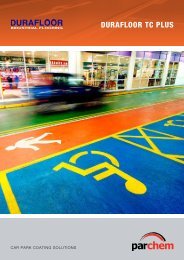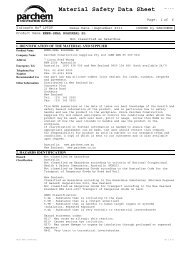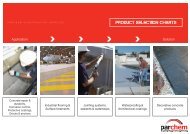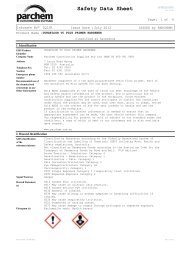Emer-Stop S100N MS - Parchem
Emer-Stop S100N MS - Parchem
Emer-Stop S100N MS - Parchem
You also want an ePaper? Increase the reach of your titles
YUMPU automatically turns print PDFs into web optimized ePapers that Google loves.
Method Statement<strong>Emer</strong>-<strong>Stop</strong> <strong>S100N</strong>Deeply impregnating, iso-butyltriethoxy silane, clear liquid, water repellant andchloride ion protective treatment for concreteSECTION A: GENERAL COMMENTSHIGH AND LOW TEMPERATURE WORKINGIt is suggested that, for temperatures above 35 o C or below 5 o C, the following guidelines are adopted as good workingpractise:I. Store unmixed materials in a cool (preferably temperature controlled) environment, avoiding exposure to directsunlight.II. In high temperature environments, keep equipment cool, arranging shade protection if necessary. It is especiallyimportant to keep cool those surfaces of the equipment that come into direct contact with the material itself.III. Try to avoid application during the hottest times of the day or when the application surface has been subject toprolonged heating, arrange temporary shading as necessary.IV. Try to avoid application during periods of strong wind conditions.V. Make sufficient material, plant and labour available to ensure that application is a continuous process.EQUIPMENTIt is suggested that the following list of equipment is adopted as a minimum requirement for the correct application of thismaterial:Protective clothing :- Protective overalls, safety helmet and safety shoes- Good quality gloves and gogglesPreparation equipment :- Stiff wire brush- Proprietary blasting equipmentApplication equipment :- Suitable brush, roller or airless spray equipment- Masking tapeAPPLICATION – POINTS OF NOTE<strong>Parchem</strong> operates a policy to encourage the use, where possible, of experienced applicators, since the long-termperformance of the materials is dependant upon proper application. For contractors who wish to apply the materialsthemselves, <strong>Parchem</strong> is also able to offer technical assistance.PARCHEM CONCRETE REPAIR FLOORING JOINTING SYSTE<strong>MS</strong> WATERPROOFINGMETHOD STATEMENT SEPTEMBER 2011www.parchem.com.au 7 Lucca Road, Wyong NSW 2259 Sales 1800 624 322 Technical 1800 812 864 ABN 80 069 961 968 1
<strong>Emer</strong>-<strong>Stop</strong> <strong>S100N</strong>SECTION B: APPLICATION METHOD1.0 WORK AREA1.1 Avoid inhalation of vapours and ensure adequate ventilation. In enclosed areas suitable breathing apparatus shall beworn.2.0 SURFACE PREPARATION2.1 Surfaces shall be 28 days cured (unless prior approval has been given by the Site Engineer), dry, free from oil, grease,loose particles (including air-born salts), decayed matter, organic growth, curing compounds or other contaminants.2.2 Where surfaces cannot be prepared to a satisfactory standard by hand, then mechanical preparation shall beundertaken, such as pressure washing.2.3 Plants, asphalt, bitumen, and chlorinated surfaces adjacent to areas to be treated shall be protected during preparationand application of the surface treatment.3.0 PRE-APPLICATION TESTING3.1 Areas for testing are to be marked out by the Site Engineer before work commences. These areas are to include areasfor silane impregnation and other non-treated areas to act as controls. To the treated test area, wipe substrate surfaceclean of any free salts using a damp cloth.3.2 <strong>Emer</strong>-<strong>Stop</strong> <strong>S100N</strong> is then applied to the test areas in the presence of the Site Engineer, in strict accordance with thecurrent Technical Data Sheet.3.3 The treated and non-treated test areas are to be cored (see coring comments in Post-Application Testing procedure).These cores are to be clearly marked, and sent for ‘Sorptivity’ Testing to an approved independent testing authority fordetermination of the depth of silane impregnation achieved an impregnation depth of 4mm is generally considered asthe benchmark depth for effective protection but this impregnation can be affected by the type of concrete used as wellas the humidity and porosity of the concrete. The amount and size of active capillary pores can vary significantlybetween concrete types and therefore affect the overall impregnation result. It is possible for example to have effectiveprotection of the concrete at only 1mm impregnation due to the very dense nature of the concrete.4.0 APPLICATION4.1 Serial/batch numbers of all drums used shall be recorded against the location of their application to the treatedconcrete.4.2 The contractor shall maintain a record of the quantity of <strong>Emer</strong>-<strong>Stop</strong> <strong>S100N</strong> used and the areas treated for eachapplication to verify the minimum required coverage rate has been achieved.4.3 <strong>Emer</strong>-<strong>Stop</strong> <strong>S100N</strong> shall be applied in a minimum of two applications until such time as 0.6 litres /m 2 has been appliedusing a low pressure continuous spray, direct from the drum. No thinning is permitted.4.4 On vertical surfaces <strong>Emer</strong>-<strong>Stop</strong> <strong>S100N</strong> shall be applied working from the lowest level upwards. There will be a minimumrun-down of 150mm and the treated area is to have a “mirror wet look” for 5 seconds.4.5 On horizontal surfaces and soffit areas the material shall be applied as above until the area has a “mirror wet look” for 5seconds4.6 A minimum interval of 6 hours shall be allowed between coats.4.7 Application of <strong>Emer</strong>-<strong>Stop</strong> <strong>S100N</strong> should not take place in rain or strong winds.4.8 In tidal zones application shall not commence until the tide has reached its lowest ebb. Application of <strong>Emer</strong>-<strong>Stop</strong><strong>S100N</strong> shall slowly precede the rising tide allowing the longest possible drying period before application.2
<strong>Emer</strong>-<strong>Stop</strong> <strong>S100N</strong>Note: <strong>Emer</strong>-<strong>Stop</strong> <strong>S100N</strong> cannot withstand a water head of pressure > 300mm.4.9 Prior to, during application and drying, it shall not be permitted to contaminate the <strong>Emer</strong>-<strong>Stop</strong> <strong>S100N</strong> with any water orsolvents.5.0 POST APPLICATION TESTING5.1 It is strongly recommend that testing of treated areas shall be carried out to determine depth of penetration and to theapproval of the site engineer. It is recommended that 1 core is taken per 300m 2 of treated area. A minimum of 14 daysand ideally 28 days following the last application of silane, 50mm internal diameter cores shall be cut through thetreated concrete ensuring that the core is perpendicular to the concrete surface. The depth of cut shall be 40mm(+ 5mm). Larger core sizes may be required for large aggregate sizes. Cores shall be marked to indicate their locationand orientation with respect to the original concrete surface.Note: Cores can be taken prior to 14 days with the Site Engineers approval.5.2 The partial cores shall be sealed in a plastic bag, labelled and sent to the same independent testing authority that testedthe Pre-application cores, for ‘Sorptivity Testing (as per CTI Consultants, Sydney).5.3 The test results will ideally show a depth of silane impregnation of 4mm and a 90% chloride uptake. Results that arelower than these values can still be acceptable depending on the formulation, humidity and porosity of the concrete aswell as the level of surface preparation undertaken.5.4 When the standards have been confirmed, the contractor will provide the Site Engineer written confirmation from theapproved Testing Authority.6.0 CLEANING6.1 <strong>Emer</strong>-<strong>Stop</strong> <strong>S100N</strong> should be removed from tools and equipment with clean water immediately after use.SECTION C: IMPORTANT NOTEThis method statement is offered by <strong>Parchem</strong> as a ‘standard proposal’ for the application of <strong>Emer</strong>-<strong>Stop</strong> <strong>S100N</strong>. It remainsthe responsibility of the Engineer to determine the correct method for any given application.<strong>Parchem</strong> does not accept any liability either directly or indirectly for any losses suffered in connection with use orapplication of the product whether or not in accordance with any advice, specification, recommendation or informationgiven by it.3




